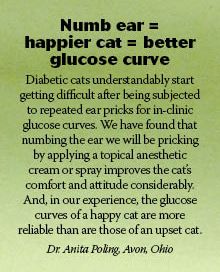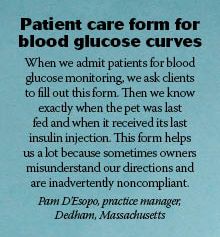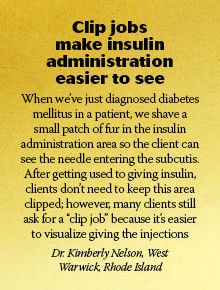Diabetes? You've got it licked! (with these dvm360 hacks)
Sweet! Hacks for overcoming everyday challenges with this common endocrine disease.
Hey, how'd you get that hack?
We asked you! No, really-in a survey, dvm360 Clinical Updates: Practice Hacks. Over a hundred veterinarians, practice managers and team members chimed in with ways to make life easier for you, your patients and your clients, which we've organized into categories (get the full list here). It's a hack jackpot (a hackpot?)! But we didn't stop there-we've also spliced in a number of Idea Exchanges from one of Vetted's parent pubs, Veterinary Medicine.
We asked about your tips and tricks for facing the difficulties of this disease in cats and dogs. Here's the cream of the crop.

Client communication: Fun with analogies
"I like to explain that metabolism is like a waterwheel on an old-fashioned mill and in a ketotic diabetic, the stream is running backward. To do something as drastic as change the flow of a stream, we may have to give insulin and dextrose at the same time."
"I explain that diabetes is like a highway system with all the exits blocked: Traffic (glucose) backs up and we need insulin to open up the exits and bring energy (glucose) back to the cells. Most clients seem to understand this simplified concept of diabete mellitus."
"When explaining the disease process, we say 'Insulin is the key to opening the cells doors' to explain why the blood glucose is high but the dog is starving."

(Click image to link to form.)Home treatment: Take the sting out of injections
"We recommend that owners give the insulin injection while the pet is still eating so that it is distracted."
"We have a stuffed animal that the technicians use to demonstrate insulin administration with the clients. The client then has a chance to practice as many injections as they need on the stuffed animal before practicing on their own pet. It makes them more comfortable, and by the time the appointment is done, the client is no longer nervous and shaking at the sight and thought of injections."

Home monitoring: Equal partners in equalizing insulin levels
"For clients using an at-home glucometer and urine dip sticks, we have them make a journal of findings. They can email or take a photo of the journal and send it to the clinic for the doctor to review. We set up follow-ups automatically to ensure we are calling to remind the client this is needed."
"We do in-house blood glucose curves every two weeks until we get a good dose for the patient, then everything three to four months to monitor patient progress. If that doesn't seem to work, we advise in-home monitoring."
"Sometimes I do not try to get to the 'exact' insulin dose based on blood glucose concentrations, especially if the clinical signs are controlled and the client does not want to pursue perfection. This is good for clients who are thinking about euthanizing instead of treating."
Apps and websites
Pet Diabetes Tracker app
CarbCalc app
Discuss appropriate protein and carbohydrate levels and then show the chart of canned food from catinfo.org